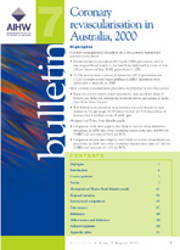Coronary revascularisation in Australia, 2000
Citation
AIHW
AIHW, Davies M (2003) Coronary revascularisation in Australia, 2000, AIHW, Australian Government, accessed 25 April 2024.
APA
AIHW, Davies M. (2003). Coronary revascularisation in Australia, 2000. Canberra: AIHW.
MLA
AIHW, Davies M. Coronary revascularisation in Australia, 2000. AIHW, 2003.
Vancouver
AIHW, Davies M. Coronary revascularisation in Australia, 2000. Canberra: AIHW; 2003.
Harvard
AIHW, Davies M 2003, Coronary revascularisation in Australia, 2000, AIHW, Canberra.
PDF | 887Kb
Heart disease is a major cause of morbidity and mortality in Australia, responsible for 20% of deaths in 2000. The most common form of heart disease affecting Australians is coronary heart disease. This involves blockages in the heart's own blood supply, the coronary arteries, by abnormal build-ups known as plaques. Two main procedures can be used to overcome the blockages by either reducing or bypassing them. Jointly known as coronary revascularisation procedures, they are percutaneous transluminal coronary angioplasty (PTCA) and coronary artery bypass grafting (CABG). This bulletin examines current patterns in coronary revascularisation procedures and explores reason for their marked increase over the last decade. To this end, data presented in this bulletin are drawn from two data sources: the national registers on cardiac surgery and coronary angioplasty (collected by calendar year) and the AIHW's National Hospital Morbidity Database (collected by financial year). The latest information available from the national registers was 1999, so data are supplemented by hospital morbidity data and reported in calendar year for comparative purposes.
- ISSN: 1446 9820
- ISBN: 978 1 74024 295 0
- Cat. no: AUS 35
- Pages: 23



